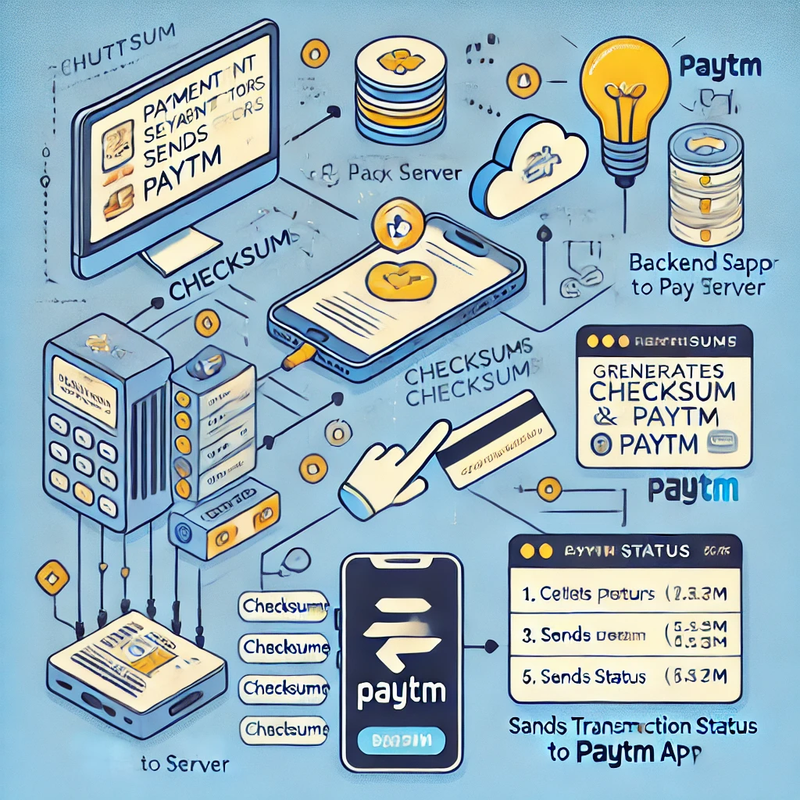Explain the role of checksum in paytm integration
who is responsible to generate checksum in paytm integration
Checksums are used in the integration of Paytm with any application, including those developed with Flutter, primarily to ensure security and data integrity during transactions. In the context of mobile app development with Flutter, using a checksum for transactions is crucial for maintaining a secure and reliable payment process. Here’s a breakdown of why checksums are essential and how they function in a Flutter-based application integrating Paytm:
Why Use a Checksum?
Security: The checksum serves as a method to verify that the data sent to and from the Paytm servers has not been altered. This protects against tampering and ensures that the data remains as it was when it left the sender.
Data Integrity: By generating a checksum before sending data and verifying it upon receipt, both parties (the app and Paytm's servers) can be confident that the data has not been changed in transit.
Authentication: The checksum helps to authenticate the source of the data, assuring that the data is indeed sent by a trusted sender and not an impersonator.
Error Detection: Besides security, checksums can also detect errors in the data transmitted over a network. Any unintended changes, such as those due to transmission errors, are likely to result in a mismatch when the checksum is checked.
How It Works in Flutter with Paytm
Here is a simple example to illustrate the process of using a checksum in a Flutter application integrating Paytm for a payment transaction:
Step 1: Generating the Checksum
When a user decides to make a payment via the Flutter app, the app collects all necessary transaction details like the amount, order ID, and customer ID. These details are then sent to your backend server.
Flutter Code:
Map<String, String> paymentDetails = {
'orderId': '123456',
'customerId': 'cust123',
'amount': '100.00'
};
Future<String> generateChecksum() async {
var response = await http.post(
Uri.parse('https://yourserver.com/api/generateChecksum'),
body: paymentDetails,
);
return response.body; // The response contains the checksum
}
Step 2: Sending Data with Checksum to Paytm
The backend server, upon receiving these transaction details, generates a checksum using a cryptographic hash function and Paytm's secret key. It then sends this checksum along with the transaction details to Paytm's payment gateway.
PHP Code on Server:
<?php
require_once("PaytmChecksum.php");
$paytmParams = array();
$paytmParams["body"] = array(
"requestType" => "Payment",
"mid" => "YOUR_MID_HERE",
"websiteName" => "YOUR_WEBSITE",
"orderId" => $_POST['orderId'],
"txnAmount" => array(
"value" => $_POST['amount'],
"currency" => "INR",
),
"userInfo" => array(
"custId" => $_POST['customerId'],
),
);
$checksum = PaytmChecksum::generateSignature(json_encode($paytmParams["body"]), "YOUR_MERCHANT_KEY");
$paytmParams["head"] = array(
"signature" => $checksum
);
// Send this to Paytm's API endpoint
?>
Step 3: Paytm Processes the Payment
Paytm receives the request, verifies the checksum, and processes the payment. After processing, it sends back the transaction status, along with a new checksum for the response data.
Step 4: Verifying the Response
Your backend verifies the response checksum to ensure the integrity of the response data.
PHP Code to Verify Response:
$responseChecksum = $_POST["CHECKSUMHASH"];
$isVerifySignature = PaytmChecksum::verifySignature($response, "YOUR_MERCHANT_KEY", $responseChecksum);
if($isVerifySignature) {
// Process the response
} else {
// Log error or alert for checksum mismatch
}
This example demonstrates how checksums play a critical role in ensuring a secure transaction process when integrating Paytm with a Flutter application. By effectively using checksums, you can significantly enhance the security and reliability of your mobile payment solutions.
who is responsible to generate checksum in paytm integration
In the Paytm integration process, the checksum is generated by the merchant's backend server. Here's a breakdown of the responsibilities and process flow:
Merchant's Backend Server: The server is responsible for generating the checksum. It uses specific parameters related to the transaction (like the order ID, customer ID, transaction amount, etc.), along with a merchant-specific secret key provided by Paytm. The server uses these elements to create a checksum using a cryptographic hashing algorithm. This checksum ensures that the data sent to Paytm's servers has not been tampered with.
Checksum Generation Process:
- The server collects all necessary parameters required for the transaction.
- These parameters are then concatenated into a string in a predefined sequence.
- The concatenated string is hashed using a secure cryptographic algorithm, along with the secret key, to generate the checksum . Sending Checksum to Paytm:
- The generated checksum is included in the transaction data sent to Paytm.
- This data packet, including the checksum, is then transmitted to Paytm’s payment gateway for processing . Paytm's Role:
- Paytm’s servers receive the transaction data along with the checksum.
- Before processing the transaction, Paytm regenerates the checksum using the same parameters and secret key.
- Paytm then compares the newly generated checksum with the one provided by the merchant's server.
- If both checksums match, Paytm proceeds with the transaction, ensuring that the data has not been altered . The responsibility for generating and verifying the checksum lies primarily with the merchant's backend server at the outset, and subsequently with Paytm’s system to ensure data integrity and security throughout the transaction process. This robust mechanism is critical in preventing fraud and ensuring secure transactions in the e-commerce ecosystem.


Top comments (0)